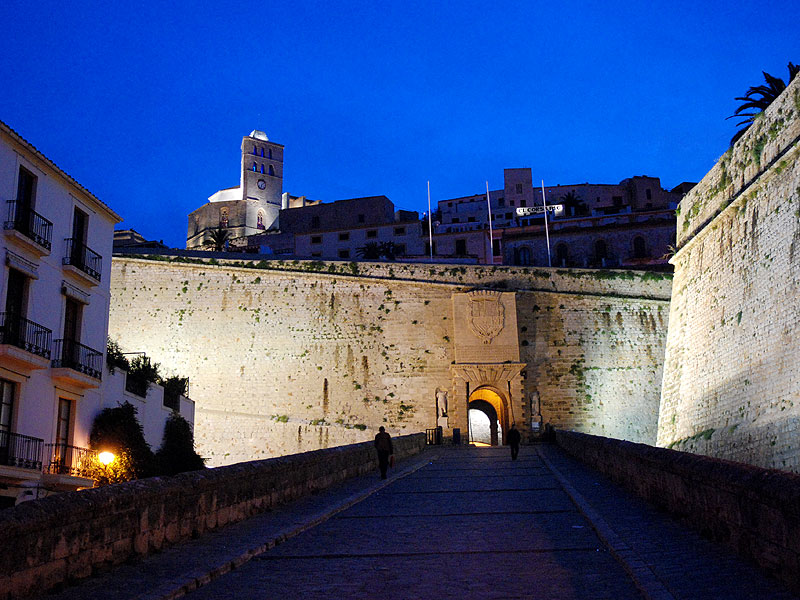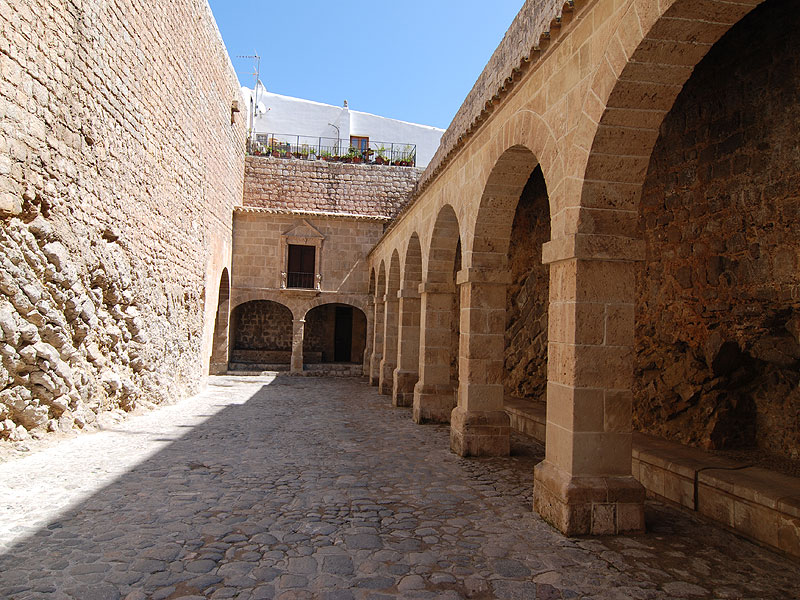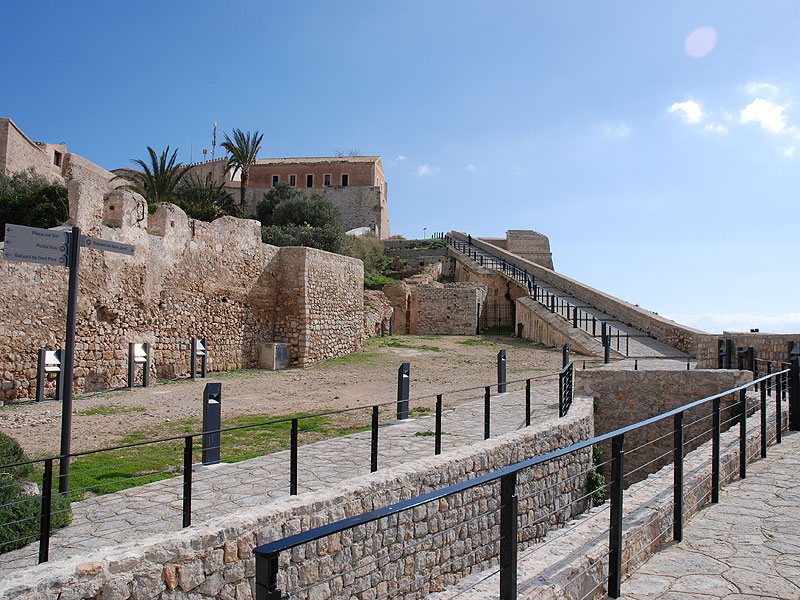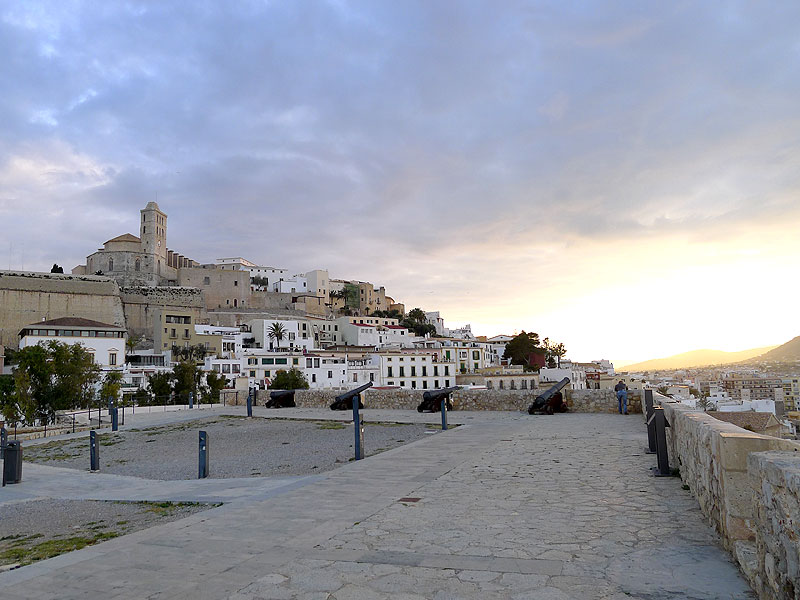
The city of Eivissa had walls from ancient times. The current fortress, however, was constructed during the Renaissance, by order of the Spanish Crown, according to the design by Italian engineer Giovanni Batista Calvi. This was because of the constant sieges by the Turkish navy and their privateers. Its construction, as seen in the section on cultural assets in Eivissa, World Heritage, concluded at the end of the 16th century.
The fortress enclosed the whole of Puig de Vila, the highest part of the Ibizan capital. It extended over a surface area of 10 hectares, with a perimeter of 1,800 metres. Each one of its seven bulwarks was planned in detail in order to equip it with sufficient firing angles that would guarantee its defence.
The Renaissance walls have five entrances, but the main one and the most spectacular is the one that occupies the main drawbridge in the Portal de ses Taules, in front of the Barrio de La Marina. At the end of the ramp up to the fortress, there are two Roman statues, one on each side. They are replicas of two marble originals that are kept in the Archaeological Museum of Dalt Vila. At the top is the Crown’s coat of arms. The Latin words that accompany it are: “Under the Catholic and undefeated King Felipe of the Spains and East and West Indias, these walls were erected for the benefit of this island. SCMR governor and general captain, nobleman Fernando Sanoguera. In the year 1585.”.

After the entrance there is a main square, the popular «portcullis», with its semi-circle arches on the side colonnade. The square also houses a Renaissance balcony.
An unforgettable stroll from bulwark to bulwark starts here, following the wall-walk’s trail that opens up to the whole city and the sea. The walk can be started from the Santa Llúcia bulwark, which has the Barrio de Sa Penya at its feet. It houses the old arsenal, constructed in the 18th century.
From Santa Llúcia you can go down Ronda Narcís Puget Viñas, next to the battlements and above the Portal de ses Taules. You will then arrive at the Sant Joan bulwark, above the Barrio de La Marina. It houses the Contemporary Art Museum of Eivissa, the old Hall of Arms and two gatehouses at the ends. This bulwark was remodelled in the 1960s in order to construct the only access way for vehicles in the fortress and it is only flanked by the neighbourhood residents and public transport.
Following the crown of the wall, it passes over the Plaça del Parc until it reaches the Plaça del Sol, the antechamber to the Sant Pere bulwark, also known as Es Portal Nou. Inside, a stage for concerts can be found along with an information centre on the construction of the walls. Es Portal Nou is the second pedestrian entrance to the enclosure and, via a tunnel, it comes out into Reina Sofía park. It is protected by a striking circular battlement. On top of it rests the Cavaller de Sant Lluc, a structure designed for artillery.

From here, the trail continues upwards on the Ronda Calvi and the Puig des Molins can be spotted at the foot of the monument, as well as the Platja d’en Bossa coast. The next bulwark is the Sant Jaume. It has a weapons information centre and the remains of the old Moorish wall from the medieval period, which is almost aligned with the next bulwark, the Sant Jordi, at the top, which coincides with the Castle.
Between the Sant Bernat bulwark and this one, there is another pedestrian tunnel, the Es Soto Fosc, also from the 16th century. As there is a car park on the outside, many visitors start their route here.

Between the Castle and the Cathedral there is a narrow alleyway that leads to the Plaça de la Catedral. From there you can turn onto Carrer Major until taking the first right and crossing the Sa Portella archway, the final access point that remains in the old medieval wall that existed before this one. From there, you can go down to the Plaça d’Espanya, next to the Town Hall, where the Ravelin is also located. It is a semi-bulwark under which the last pedestrian tunnel in the enclosure passes. It also leads to the Es Soto Fosc area and it was constructed during the Spanish Civil War in the 1930s. From there, we return to the Santa Llúcia bulwark where we started the walk, but only after taking in the extraordinary views of the port and Guillem de Montgrí’s tomb from the lookout in la Plaça d’Espanya. He was the Archbishop of Tarragona who launched the conquest of Ibiza in the 13th century.
This unforgettable journey along the perimeter of the wall should not stop you taking another equally interesting journey through the streets and squares within Dalt Vila, where you will find unique places in addition to interesting monuments and museums.
